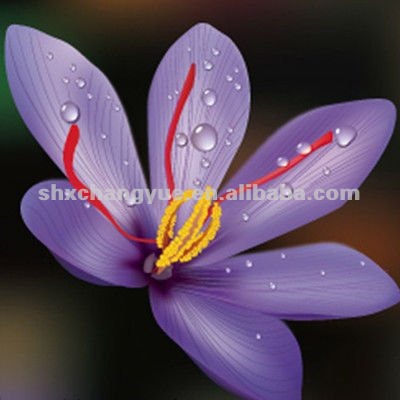
 Seven years of qualification
Seven years of qualification
 Audited Supplier
Audited Supplier
In This Store
Category:Natural Extracts > Plant Extracts
Product Name:saffron crocus extract
CAS No.: 42553-65-1
Standard:ChP
Price(USD):50.00
Company:Xi`an Changyue Biological Technology Co., Ltd,
Grade: Pharmaceutical Grade
Factory Location: Xi'an Shaanxi China
Main Sales Markets: North America,Central/South America,Western Europe,Eastern Europe,Australasia,Asia,Middle East,Africa
Monthly Production Capacity: 1000kg
Packaging Information: 25kg/drum
Delivery Lead Time: within 7 days
Sample Provided: yes
Payment Terms: T/T
1.Quick details:
Botanic Name:Carthamus tinctorius.
Latin Name: Crocus Sativus L.
Plant Part:Flower (Dried, 100% Natural).
Type of Extraction:Water/ Grain Alcohol.
Country of Origin:P.R. China.
Active Ingredient:Crocin and Safranal.

------------------------------------------------------------------------------------------------------------------------------------------
2.Main Fuction:

------------------------------------------------------------------------------------------------------------------------------------------
3.Description:
Saffron is a spice derived from the flower of Crocus sativus, commonly known as the saffron crocus. Crocus is a genus in the family Iridaceae. Each saffron crocus grows to 20–30 cm (8–12 in) and bears up to four flowers, each with three vivid crimson stigmas, which are each the distal end of a carpel.Together with the styles, or stalks that connect the stigmas to their host plant, the dried stigmas are used mainly in various cuisines as a seasoning and colouring agent. Saffron, long among the world's most costly spices by weight, is native to Southwest Asia and was first cultivated in Greece. As a genetically monomorphic clone, it was slowly propagated throughout much of Eurasia and was later brought to parts of North Africa, North America, and Oceania.
The saffron crocus, unknown in the wild, likely descends from Crocus cartwrightianus, which originated in Crete or Central Asia; C. thomasii and C. pallasii are other possible precursors. The saffron crocus is a triploid that is "self-incompatible" and male sterile; it undergoes aberrant meiosis and is hence incapable of independent sexual reproduction—all propagation is by vegetative multiplication via manual "divide-and-set" of a starter clone or by interspecific hybridisation. If C. sativus is a mutant form of C. cartwrightianus, then it may have emerged via plant breeding, which would have selected for elongated stigmas, in late Bronze-Age Crete.
------------------------------------------------------------------------------------------------------------------------------------------
4.Storage & Packing:
Shelf Life:Two years when properly stored.
Storage: Store in Cool and dry place, keep sealed and keep away from strong light, hight temperature.
Packing: 25kg/drum, with double plastic bag of foodstuff inside and cardboard drum outside.


Contact Us
Tel: (+86) 400 610 1188
WhatsApp/Telegram/Wechat: +86 13621645194
Follow Us:




 Pharma Sources Insight January 2025
Pharma Sources Insight January 2025


